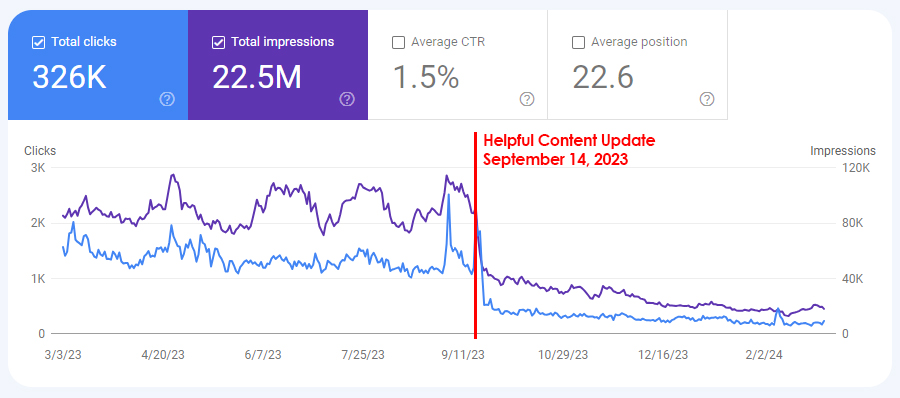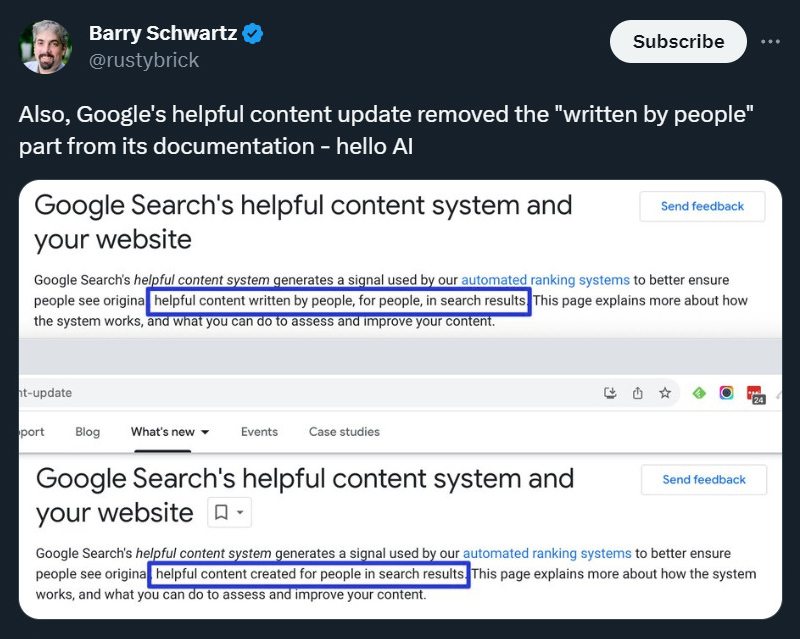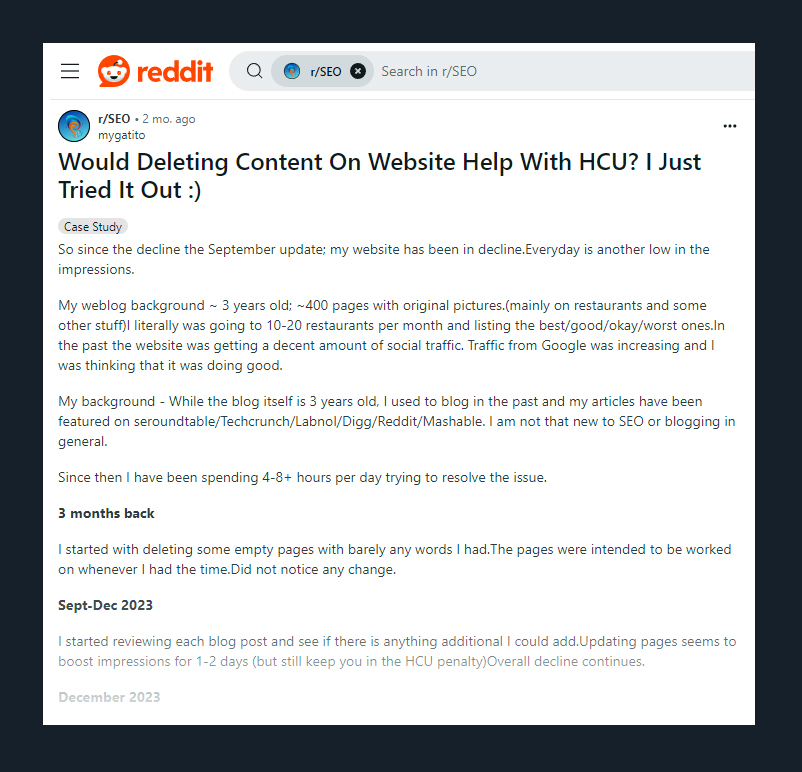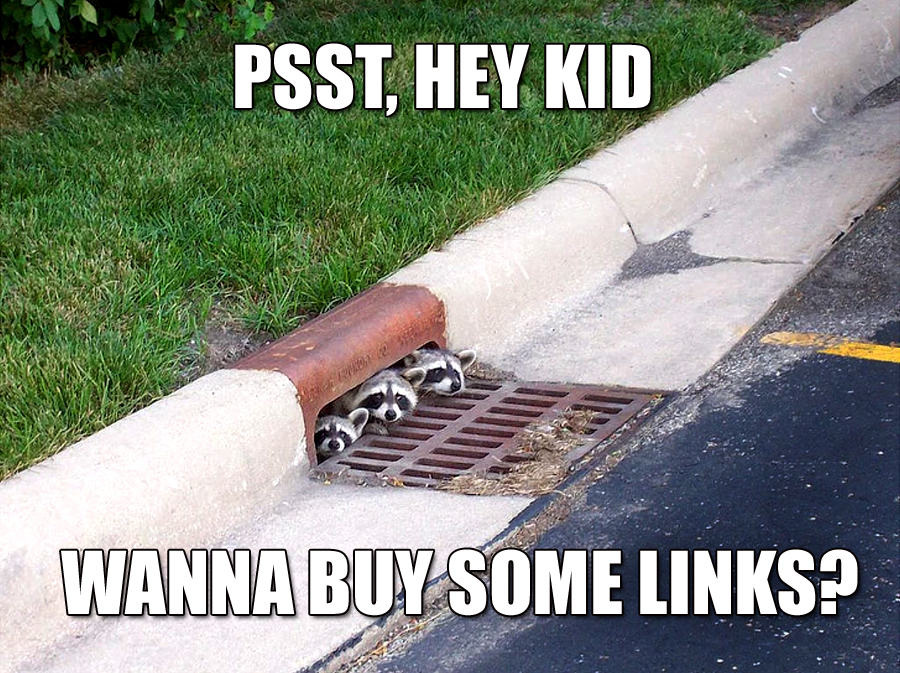
I encountered Google's Helpful Content Update almost immediately after its release. In early October 2023, an SEO colleague approached me with a question: How can we recover website traffic following the Helpful Content Update?
He showed me a website traffic chart that had significantly declined since September 17. Notably, even low-frequency, non-commercial queries that had never dropped before were now plummeting in search results.
Later, I observed similar traffic trends in other websites we were considering for guest posting as part of our list of 902 Free Guest Posting Sites. One of the most critical criteria for selecting websites for guest posting is the absence of sharp drops in organic traffic. A sharp drop indicates that the website might be unhealthy and possibly penalized by Google.
I analyzed dozens of websites for guest posting that experienced a sharp decrease in organic traffic starting September 14, 2023. Google officially announced the Helpful Content Update on September 14, and its implementation was fully completed by September 28. Most websites affected by the Helpful Content Update began to feel a loss in Google traffic approximately between September 17 and 20.

So, if your website's traffic graph looks similar to this, it's likely it was impacted by Google's Helpful Content Update.
However, there's no need for despair - let's figure out how to help your website quickly regain its previous visitor numbers.
NOTE:
It's worth mentioning that if your website's traffic began to decline before September 14, the cause might be the Google Core Update 2023, which was finalized on September 7. This update targeted websites with insufficient page loading speed. Furthermore, another Google Spam Update 2023 occurred in October, penalizing websites engaged in spammy link building.
But our focus here is specifically on the HCU. In this article, I'll share my observations and conclusions drawn from analyzing many websites affected by the HCU. In the latter half, you'll receive practical guidance on what needs to be done to lift your website from under the sanctions of the Helpful Content Update.
Why Did Google Release the Helpful Content Update?
The first thing to understand is that Google's Helpful Content Update is not an update to Google's core search algorithm. It's a completely independent AI-driven system known as Google's Helpful AI classifier, whose goal is to make you suffer for many days and nights...
Just kidding :) The purpose of Google's Helpful AI classifier, in brief, is to identify and demote websites containing useless content.
Here's what Google itself says about it:
"The system automatically identifies content that seems to have little value, low-added value, or is otherwise not particularly helpful to people."
Indeed, most of the websites affected by the HCU that I've analyzed were of low quality and contained blatantly weak content. Often, this content appeared to be AI-generated, and it likely was. Such websites typically exist solely for the sale of guest posts and links. Therefore, it's not surprising that their owners don't bother creating quality and useful content.
With the release of GPT-4 in March 2023, the situation started to escalate alarmingly - content became unprecedentedly cheap. Humanity has never had access to content as affordable as it is now. Webmasters began to create hundreds of thousands of articles on various topics en masse. And a vast number of websites and blogs started to publish tons of new pages with AI-generated content.

I'm convinced Google was not pleased with this development. Now, it required significantly more resources to index the suddenly increased number of pages on the web.
And it is the Helpful Content Update that Google has tasked with addressing this issue. It aims to deter webmasters from generating thousands of new pages of useless content, many of which will never be read.
But is the issue solely with the use of AI content creators, or does the problem have deeper roots?
Does the Helpful Content Update Penalize AI-Generated Content?
Google does not officially claim that the Helpful Content Update targets AI-generated content. On the official page titled "Google Search's helpful content system and your website," there's no mention that AI-created content is bad or that websites featuring it will be penalized.
Furthermore, before the HCU was released, the document included the following statement:
"Google Search's helpful content system generates a signal used by our automated ranking systems to better ensure people see original, helpful content written by people, for people, in search results."
However, Google soon revised this to:
"Google Search's helpful content system generates a signal used by our automated ranking systems to better ensure people see original, helpful content created for people in search results."

This modification implies that Google no longer insists on content being "written by people, for people". Now, it simply needs to be "created for people". This subtly opens the door to the use of AI content creators, although, of course, Google does not explicitly endorse this approach, which is unsurprising.
I tend to take official statements from Google representatives with a grain of salt, preferring to verify their accuracy through practical application. Here, I must acknowledge that using AI-generated content is not automatically a basis for penalizing a website.
I've encountered websites that featured original content written by humans and yet were demoted by the Helpful Content Update. Conversely, there were cases where websites published content entirely generated by AI software without incurring any penalties from the HCU. This was easily identifiable just by reading the first few sentences. And these websites did not experience any traffic declines.
These are not isolated incidents; there are quite a few such cases.
Therefore, the answer to whether the presence of AI content is a determining factor for demotion by the Helpful Content Update is no, it is not.
Which Websites Were Demoted by the HCU?
After examining dozens of websites affected by the release of Google's Helpful Content Update, I've identified probable reasons for their demotion by the HCU.
1. Websites with Weak Content
This refers to what Google describes as "unhelpful content," which offers no value to readers and is considered by Google to be useless, rendering the pages unnecessary.
One might wonder what constitutes unhelpful content for Google, but I can summarize it briefly:
If you read content and learn nothing new, finding it difficult to engage with because it's dull, filled with fluff, and repetitive, then it's clearly weak content.
And yes, in most cases, such content is generated by AI tools rather than crafted by humans.
2. Websites with SEO-Overoptimized Content
Every SEO specialist knows that content is king, and SEO-friendly content is king squared. However, the issue arises when "SEO friendly" boils down to a lengthy list of keywords that the copywriter must incorporate into the article. The same applies to titles H1, H2, H3, and meta descriptions.

Unfortunately, sometimes this "SEO friendly" content becomes unreadable and repulsive. It's no surprise that many visitors close the page after barely reading the first paragraph. This mass behavior of visitors cannot go unnoticed by Google's vigilant Helpful AI classifier. Audience interaction with a website (page) is one of the factors that help the Helpful AI classifier determine the content's value to readers.
3. Websites with Minimal Text Content on Pages
If a page has scant textual content, Google may deem it useless and created solely for garnering search traffic. Interestingly, having numerous images on a page, with only a brief textual description, is a direct ticket to being affected by the Helpful Content Update.
This situation is quite common, and many webmasters have encountered it:

From this, it can be inferred that for Google's Helpful AI classifier, there exists a minimum threshold of text quantity below which it perceives content as insufficiently informative and, consequently, not useful enough for visitors. Moreover, according to Google, a lack of text cannot be compensated for by an abundance of visual content like photos, charts, or videos.
However, this particularly applies to blog pages. For instance, if you have a business website with a service description page that contains little textual content, it won't be a problem.
But if you run a blog or online magazine where more than half of the pages have just a few lines of text, the likelihood of penalties from the Helpful Content Update significantly increases.
4. Websites with Irrelevant Content
These are cases where websites contain pages whose themes diverge from the website's main topic. Google describes such content as "unnecessary information for the user." For example, a Web Design blog publishing articles about choosing refrigerators alongside web design articles.
This is a common mistake among websites that earn from selling sponsored and guest posts. Typically, such websites rarely limit themselves to one niche and create additional categories to capture more clients.
I've seen many such websites suffer from the Helpful Content Update. Moreover, they often also had weak content generated by AI software.
5. Websites that Do Not Credit Content Authors
These are instances where articles lack an attributed author or reviewer, or if mentioned, the person is not an expert in the subject matter or is entirely fictitious.
Google's document "Creating helpful, reliable, people-first content" states:
"Is this content written or reviewed by an expert or enthusiast who demonstrably knows the topic well?"
Previously, having an expert author was a mandatory condition for medical sites. Now, it seems to apply across all niches. While this is not a categorical requirement from Google (at this moment), this factor is undoubtedly considered by Google's Helpful AI classifier when assessing content usefulness.
How Does the Helpful Content Update Work?
Now that we understand what triggers Google's Helpful Content Update, let's clarify how it operates.
Firstly, it's essential to comprehend that the Helpful AI Classifier is a fully independent AI system that functions automatically and is separate from Google's core algorithm. This distinction is crucial.
The Helpful AI classifier evaluates each page of a website individually but issues a verdict for the entire site. Therefore, if it detects a multitude of pages with content deemed useless, it will downgrade the ranking of the entire website. Conversely, if the number of pages with useless content is insignificant (in the view of the Helpful AI classifier), there may be no penalties from the HCU or they may be minimal.
Google's documentation suggests that the HCU can reward websites whose content is determined to be useful for visitors:
"The helpful content system aims to better reward content where visitors feel they've had a satisfying experience..."
However, in practice, I've yet to see websites that experienced a significant increase in Google traffic following the HCU implementation. On the contrary, there are many websites with plummeting traffic. Based on this, I can infer that Google's Helpful Content Update does not reward "good" websites with useful content but merely penalizes those with a lot of useless content.
Interestingly, Google later confirmed that the Helpful Content Update currently operates solely as a penalizing mechanism, and a reward system for "helpful content" is still in development.

I also noticed that most websites affected by the Helpful Content Update had blogs with numerous content pages, often WordPress blogs.
I reviewed many online stores with very weak content on product description pages. Often, these descriptions were AI-generated and insufficiently good. Yet, these online stores did not receive HCU penalties. The same applies to Category pages with added textual descriptions.
All this leads me to surmise that Google's Helpful Content Update specifically targeted blogs and informational websites that massively generated low-quality pages to attract more Google traffic. And, of course, AI-generated content was primarily used for these purposes.
How to Lift Your Website from HCU Sanctions?
First off, here's what Google itself recommends:
"If you've noticed a change in traffic you suspect may be related to this system (such as after a publicly-posted ranking update to the system), then you should self-assess your content and fix or remove any that seems unhelpful."
The crux of the matter lies in understanding what "unhelpful content" means in the eyes of Google's Helpful AI classifier. To improve or remove "unhelpful content," we need to precisely grasp what this signifies for Google. I emphasize "for Google" because content that is useful to people may not be deemed sufficiently useful by Google's Helpful AI classifier. And here's why.
Google's Helpful AI classifier has a unique way of assessing the usefulness or uselessness of content and a website as a whole. Utilizing AI, it can fully comprehend the subject matter of a page. For example, it might notice that content lacks factual information, statistical data, technical details (if required by the topic), or determine that content is filled with fluff, which AI and some copywriters are fond of. Or it might judge a page as having too little text to be considered useful, whereas in reality, the amount of text might be adequate to answer a visitor's query.
Moreover, Google's Helpful AI classifier examines how visitors interact with the content. The aggregation of these data points processed by AI triggers the evaluation process of the page and the website as a whole.
Visitor Interaction with the Website
It's long been known that Google uses behavioral factors as one of the ranking criteria for websites. But now, AI allows this to be done much more accurately and likely much better. It can see and evaluate how long and how many pages a user searches for. How a user interacts with the site they navigated to from the search. It can also track how many users return to the site after some time or how many people close the site and go back to the search results. Now, it uses more sources of information than before, including data collected through mobile devices, browsers, Gmail, etc. Thus, the analysis of visitor interactions with websites has reached an entirely new level.
Therefore, we can definitively say that the Helpful AI classifier considers the following:
- The average time a user spends on a page.
- How much content is viewed. Does the user scroll through the page entirely or leave after only seeing the first screen?
- After viewing the page, does the user return to the search or are they satisfied with the content on the current page?
Given this, to remove HCU penalties, one needs to do the following:
1. Remove Content Pages That Lacked Organic Traffic Before the HCU
First, analyze all content pages, such as blog posts and articles. The goal is to identify which pages did not have organic traffic even before the Helpful Content Update. I use a timeframe of 6 months prior to September 14, 2023. If a page had fewer than 10 visitors during this period, it's considered ineffective and should be deleted. Depending on your website's traffic and niche, your threshold might vary.
Important points:
- Content pages that don't receive Google traffic usually don't get much traffic overall. However, sometimes there are pages that attract significant traffic from social networks but none from Google. For example, blog articles with viral content. It's better not to delete such pages but to try improving their content instead.
- Before deleting, check which other pages on your website link to this page. Remove these links before deleting the page.
- After deleting the page (or even before), inform Google through the Search Console that the page no longer exists and should not be indexed. This will significantly speed up the process of removing unnecessary pages from Google's index.
- If the deleted page had backlinks, consider doing a 301 redirect from this page to another relevant page on your website, provided the backlinks are not spammy. Otherwise, it's better to simply delete the page and let it return a 404 Error.
2. Improve the Content of Remaining Pages
Divide the remaining pages that were not deleted into two groups.
The first group includes highly visited pages with genuinely high-quality content written by humans. It makes sense to enhance this content by adding current information. This doesn't necessarily mean adding a new separate section; you can update some sections as needed. The goal of such content updates is to make it more relevant and useful for visitors.
The second group comprises less visited pages with outdated, SEO-overoptimized, poorly written, or dull content. In other words, despite having organic traffic, their content is still weak. In this case, it's necessary to rewrite the content either partially or entirely.
NOTE:
Pay special attention to SEO-friendly content that has an excessive number of keywords. How to determine this? You can use specialized software (e.g., SurferSEO) or do it manually. Simply read the content and assess how easily it's understood.
3. Attribute Content to Its Author
Every content page should clearly indicate its author, who must be a qualified expert in the subject matter.
I advise against using fictional authors, whose authenticity is easily verifiable. If your author doesn't have a presence on Twitter, Facebook, LinkedIn, or there's no information about them online, Google is likely to consider them fake.
Thus, it's wiser to engage real authors-experts, which is a more reliable approach. Articles by genuine experts tend to be more trusted by readers.
If you decide to create fictitious expert authors (which I do not recommend), ensure there is supporting information available online, including active social media accounts and profiles in relevant communities. However, be prepared for the possibility that Google may eventually expose them.
4. Increase Brand Traffic
I've noticed that many popular and well-visited websites with weak content pages were not affected by the Helpful Content Update. This is not simply due to the authority and fame of these sites, as some might think.
It's believed that a significant amount of brand traffic plays a role. This is when a site receives a high volume of traffic through Google searches for its brand or company name. The logic is that if users search for the site by its name/brand or return to it, it's likely to be useful. Consequently, achieving a certain percentage of brand traffic means the Helpful AI classifier sees no need to scrutinize its content, thereby saving its resources.
This is just a hypothesis, as there are, of course, no official confirmations. However, brand traffic itself is excellent for improving a website's search ranking overall. Therefore, paying attention to brand traffic is worthwhile. Ways to increase brand traffic is a substantial topic, and I may write a separate guide on it.
How Quickly Does Traffic Recover After HCU Sanctions?
Let me be clear - it's not quick. It can take several months after making corrections.
Here's how Google answers this question:
"Our classifier runs continuously, allowing it to monitor newly-launched sites and existing ones. As it determines that the unhelpful content hasn't returned in the long-term, the classification will no longer apply."
The phrase "in the long-term" deserves attention here. The duration of this period is unknown to us. It might be necessary to wait for a new Helpful Content Update to be released to get rid of the penalty. And it could happen at any time. Therefore, the best course of action is to conduct a thorough review and improvement of your content and then wait patiently. Your efforts will be rewarded.




